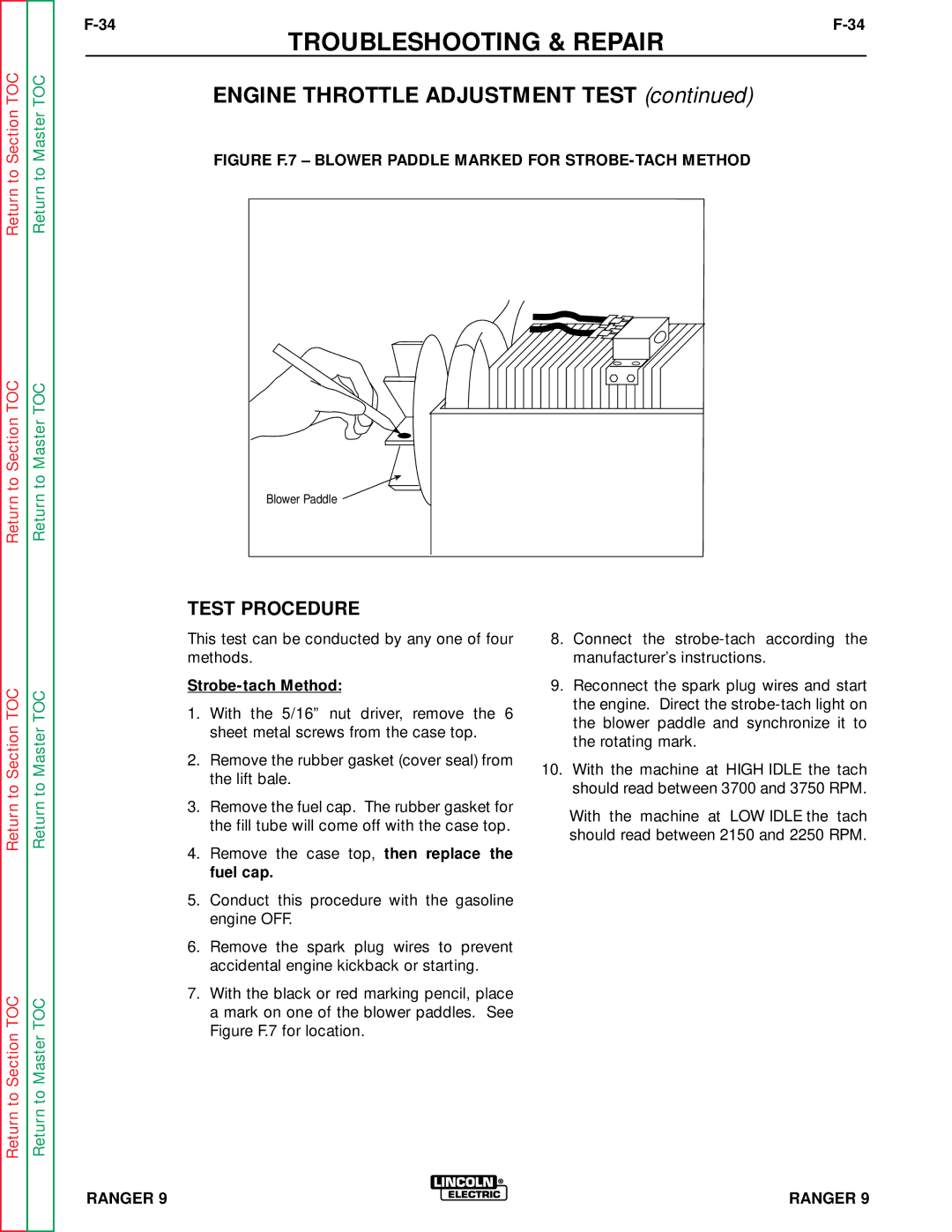Ranger TM
California Proposition 65 Warnings
Safety
Electric Shock can kill
Cylinder may explode if damaged
Précautions DE Sûreté
Master Table of Contents for ALL Sections
Table of Contents Installation Section
Technical Specifications Ranger
Installation
Storing
Safety Precautions
Location and Ventilation
Stacking
PRE-OPERATION Engine Service
Tilting
Lifting
Spark Arrester
Electrical Output Connections
Muffler Relocation
Cable Length
Welding Cable Connections
Circuit Breakers
Premises Wiring
Auxiliary Power RECEPTACLES, PLUGS, and HAND-HELD Equipment
Figure A.2 Connection of Ranger 9 to Premises Wiring
Table of Contents Operation Section
Operation
Safety Instructions
Operating Instructions
General Description
Operational Features and Controls
Design Features Advantages
Recommended Applications
Welder
Welding Capability
Controls and Settings
Limitations
Return to Section To Section TOC
WELDER/GENERATOR Controls
Operation
Gasoline Engine Controls
Engine Operation
Starting the Engine
Before Starting the Engine
Stopping the Engine
BREAK-IN Period
Operation
General Information
Welding Operation
To Use the Ranger 9 for AC/DC TIG Constant Current Welding
Operation
Table B.3 Summary of Welding Processes
Summary of Welding Processes and Machine Settings
Powering Motors
Auxiliary Power
Output Selector
Table B.5 Simultaneous Welding and Auxiliary Power
Suggested Power Applications Running Watts Start-up Watts
Table B.6 Typical Generator Power Applications
Table of Contents Accessories
OPTIONS/ACCESSORIES
TIG Welding
Moving Parts can injure
Connection of Lincoln Electric Wire Feeders
Electric Shock can kill
Figure C.2 Ranger 9/LN-25 Across the ARC Connection Diagram
Accessories
Accessories
Accessories
Connection of the LN-8 to the Ranger 9 see Figure C.6
Figure C.6 Ranger 9/LN-8 Connection Diagram
Connection of the LN-742 to the Ranger 9 see Figure C.7
Figure C.7 Ranger 9/LN-742 Connection Diagram
115V Receptacle
Table of Contents Maintenance
Engine Maintenance
Routine and Periodic Maintenance
Figure D.1 OIL Drain and Refill Location
Figure D.2 AIR Cleaner COMPONENTS, Onan Engine
Figure D.3 SET Spark Plug GAP
Every 25 Hours
Daily or Before Starting Engine
Every 50 Hours
Every 100 Hours
WELDER/GENERATOR Maintenance
Battery Maintenance
Figure D.4 Brush Removal and Replacement
Figure D.6 Major Component Locations
Table of Contents Theory of Operation Section
Theory of Operation
BATTERY, STARTER, ENGINE, ROTOR, STATOR, and Idler Solenoid
Rotor Field FEEDBACK, AUXILIARY, and Wire Feeder Power
Figure E.4 Weld WINDING, REACTOR, and Range Switch
Weld WINDING, REACTOR, Range Switch
Output BRIDGE, CHOKE, Polarity SWITCH, and Output Terminals
Table of Contents Troubleshooting & Repair Section
HOW to USE Troubleshooting Guide
Troubleshooting & Repair
PC Board can be damaged by static electricity
PC Board Troubleshooting Procedures
Output Problems
Troubleshooting Guide
Perform the Output Rectifier
Field Winding Voltage Test
Adjustment Test
Troubleshooting Guide
Troubleshooting & Repair
Engine Problems
Welding Terminals
Charging Circuit Test
Welding Problems
Function Problems
Perform the Auxiliary and Field
Troubleshooting & Repair
Remotely Controlled
Tor drops out, then make sure
Materials Needed
Rotor Voltage Test
Test Description
Test Procedure
Rotor Resistance Test
Rotor Resistance Test
Troubleshooting & Repair
Auxiliary and Field Winding Test
Auxiliary and Field Winding Test
To test the field winding
Figure F.4A 14 PIN Amphenol PIN Assignments
To test the feeder winding
Troubleshooting & Repair
Output Rectifier Bridge Test
Output Rectifier Bridge Test
Charging Circuit Test
Charging Circuit Test
Engine Throttle Adjustment Test
Strobe-tach Method
Engine Throttle Adjustment Test
Frequency Counter Method
High Idle Adjustment NUT LOW Idle Adjustment NUT
Oscilloscope Method Vibratach Method
High Idle no Load Output Control AT Maximum
Scope Settings
Normal Open Circuit Voltage Waveform 115VAC Supply
Machine Loaded to 250 Amps AT 25VDC
Typical DC Weld Output Voltage Waveform CV Mode High TAP
Machine Loaded
Machine Loaded to 250 Amps AT 25 VDC
Typical DC Weld Output Voltage Waveform
Typical AC Weld Output Voltage Waveform
Abnormal Open Circuit DC Weld Voltage Waveform
Abnormal Open Circuit Weld Voltage Waveform High CV Mode
Normal Open Circuit Weld Voltage Waveform High CV Mode
Normal Open Circuit DC Weld Voltage Waveform
Normal Open Circuit AC Weld Voltage Waveform
Description
Brush Removal and Replacement
Procedure
Brush Removal and Replacement
Figure F.10 Brush LEADS/BRUSHES Retained with Cable TIE
Slip Rings
Field Capacitor AND/OR Rectifier Bridge Removal Replacement
Field Capacitor AND/OR Rectifier Bridge Removal
Replacement
Procedure Rectifier Bridge Removal and Replacement
Printed Circuit Board Removal Replacement
Figure F.12 Printed Circuit Board Location
Printed Circuit Board Removal and Replacement
Printed Circuit Board Removal
Output Rectifier Bridge Removal Replacement
Output Rectifier Bridge Removal
Remove the case top, then reinstall the fuel cap
To Section TOC
Output Capacitor Removal Replacement
Output Capacitor Removal
Section TOC
Output Contactor Removal Replacement
Figure F.15 Output Contactor Location
Output Contactor Removal
Troubleshooting & REPAIRs
Instructions
ENGINE/ROTOR Removal and Replacement
Figure F.17 Component LOCATIONS, ENGINE/ROTOR Removal
ENGINE/ROTOR Removal
Engine and Rotor Removal Procedure
Figure F.18 Engine and Rotor Removed from Stator
Rotor Removal Procedure
Reassembly Procedure
Replacement KIT S20788
Retest After Repair
Table of Contents Diagrams Section
Wiring Diagram Ranger 9 Onan Code
Diagrams
Ranger 9 Onan CSA Version
Wiring Diagram Ranger 9 Onan CSA Code
Snubber
Control PC Board L9062 Schematic
CLEVELAND, Ohio U
RF Bypass PC Board M16675 Schematic
Dimension Print
Control PC Board L9062 Layout
TP1 MOV-50VRMS,15J,14MM
Control PC Board L9062 Components
RF-BYPASS PC Board M16675 Layout
Bypass
Description
RF-BYPASS PC Board M16675 Components

